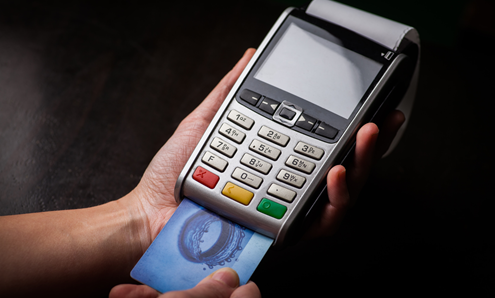We’re all familiar with the old-school tills of yesteryear: that memorable ‘ding’ when the cash register opened, the shop assistant manually inputting the price of each item sold, and some of you might even remember a time when tills were cash only.
Flash forward to the present day and such a system can seem pretty prehistoric thanks to the introduction of point-of-sale (POS) till systems. And now, electronic point of sale (EPOS) systems have revolutionised payments further, making them quicker, simpler, and safer than ever before.
Learn more about EPOS and how they can transform your business with our easy guide.#
What is an EPOS system?
EPOS stands for ‘electronic point of sale’, and an EPOS system refers to point-of-sale (POS) equipment combined with extra hardware and software components to create a computer-based till system for taking transactions.
Many EPOS models feature a range of integrated functions that can help businesses to become efficient and streamlined. These include processing and managing purchases, tracking inventory, and generating reports.
Essentially, EPOS systems are a core feature of daily business operations and can help to enhance the overall customer experience.
What’s the difference between EPOS and POS systems?
EPOS and POS systems are often used interchangeably, and while they are very similar in some aspects, they also have their differences.
A point-of-sale is an umbrella term for the method, area, or set-up businesses have in place to accept face-to-face transactions. They don’t necessarily refer to a specific piece of hardware or process; they can cover traditional mechanical tills, electronic hardware, or a mix of both.
On the other hand, EPOS systems are upgraded point-of-sales that have access to online and cloud-based storage so that all data can be accessed remotely from separate devices. As EPOS systems use central servers to exchange and store data, they tend to be more secure and there is less risk of businesses losing data.
Think of EPOS systems as more advanced versions of POS systems that use the latest digital technology and increased capabilities to make life much easier for business owners.
How do EPOS systems work?
Much like traditional tills, EPOS work in a similar way: they take and process a payment, then keep a record of the transaction.
However, EPOS systems’ ability to connect purchases to an integrated processing system and wealth of additional features means that their functionality extends much further than this.
EPOS can help manage inventory levels, provide regular reporting, and show up-to-date pricing information, all at your fingertips. With all of this readily available within a central computer or device, EPOS systems can help you breeze through everyday trading as well as all the behind-the-scenes that go into keeping your business running.
What are the key features of EPOS systems?
To find out more about how exactly EPOS systems work, let’s split them into four main components: hardware, software, data, and payments.
EPOS hardware
Typically, EPOS hardware includes:
- A computer or tablet – This is usually the central device that runs the EPOS software and acts as the user interface. These are often touchscreen to let staff easily input information and navigate the software.
- A barcode scanner or Radio Frequency Identification (RFID) reader – When processing a transaction, a barcode scanner reads product barcodes to quickly and accurately identify each item on the EPOS software.
- A cash drawer – Just like traditional tills, a cash drawer securely stores any cash received from sales transactions.
- A receipt printer – A receipt printer is a small device that uses ink or thermal paper to create a physical record of each transaction.
- A card machine – For taking card payments, card machines electronically send money from the customer to the business’s merchant account via chip and PIN, contactless, or e-wallet methods like Apple and Samsung Pay.
EPOS software
Key features of EPOS software include:
- Transaction processing – This allows users to initiate and complete sales transactions, including product scanning, pricing, and calculating totals.
- Inventory management – For any business that sells physical products, having accurate stock information is essential. EPOS software tracks and updates inventory levels in real-time.
- Reporting and analytics – Advanced reporting, analytics on sales, inventory, and other business metrics, help businesses to make informed decisions.
- Integration – EPOS systems often integrate with other services like accounting or CRM software to share data seamlessly.
- User management – For businesses with several staff members, they can set up multiple user accounts with different access levels for security and accountability.
EPOS data
EPOS system data includes:
- Sales data – Transaction details such as items sold, prices, quantities, and timestamps.
- Inventory data – Information about stock levels, stock movements, and product information.
- Customer data – Details like customer names, contact information, purchase history, and loyalty program information.
- Employee productivity – Some EPOS systems can also provide information on employees as well as customers. They can show usage levels to help business owners manage schedules and rotas. Staff performance reports will also show you who’s selling what, allowing you to quickly and painlessly rectify any training gaps.
EPOS payments
EPOS systems facilitate payment processing and can support various payment methods, including:
- Cash – EPOS systems calculate change due and manage cash in the cash drawer.
- Credit/debit cards – Integration with payment processors allows for secure card payments.
- Mobile payments – Support for payments made through mobile e-wallets or payment apps.
- Contactless payments – EPOS systems can accept payments via contactless methods.
Types of EPOS systems
As EPOS technology evolves, more options become available for businesses to suit their needs. Here are three common types:
All-in-one EPOS
All-in-one EPOS systems usually consist of a single integrated unit combining both hardware and software components. Perfect for businesses who need a full-scale solution that stays at a fixed location, all-in-one EPOS systems offer comprehensive functionalities and are ideal for processing lots of transactions.
Here at takepayments, our tPOS complete system features all the hardware and software your business needs to level up your processes – all packaged up in a user-friendly, dual-screen portal that can be integrated with a number of additional devices.
Mobile EPOS
Mobile EPOS systems are designed to operate on mobile devices, such as smartphones or tablets, with a separate card reader and receipt printer to which they can be connected. With maximum portable appeal, these are ideal for small businesses that move from one spot to another and must be able to accept payments from anywhere.
Tablet EPOS
Tablet EPOS systems function similarly to mobile EPOS, but they use tablets as the primary device for transaction processing and management. While they are just as portable and can be used on the move, tablet EPOS usually have more processing power and can handle increased usage.
Our tPOS counter is a tablet-sized system that sits sleek and stylish at any checkout area. A powerful quad-core processor powers the large touchscreen display to help you take charge of your business.
What are the benefits of EPOS?
More and more businesses are switching to EPOS – and with good reason!
As well as increased usage, EPOS systems tend to be much more reliable and accurate than old-school till systems – reducing the margin for error so businesses can make every exchange or transaction with confidence.
1. They speed up the payment process
Even a nation of queuers like us Brits has its limits when it comes to queuing up to pay. In fact, the exact time it takes the average consumer to give up and walk away is six minutes and 46 seconds.
It’s not just shoppers who get frustrated by a slow payment process, but staff too. Watching a line get longer and longer while working hard to clear the backlog gets pretty stressful.
EPOS systems with integrated payments mean the till speaks directly to the EPOS, so there's no manual typing involved. This helps facilitate faster payments, preserving customer satisfaction and helping prevent businesses from losing a customer to a competitor.
With an integrated system, you could shorten waiting times and serve more customers in a shorter space of time.
2. They eliminate human error
Charging the customer incorrectly could seriously damage your reputation and make you look pretty unprofessional to boot.
Along with increasing the speed of transactions, cutting out the need to manually input transaction amounts means that mistakes are far less likely to occur. After the product has been scanned, the EPOS system speaks to the card machine and automatically inputs the correct payment amount.
Connecting your payments systems also means avoiding duplicate payments and chargebacks while protecting your business from accidental underpayments – it’s a win-win situation.
3. Reduce the opportunity for staff theft
We know it’s something no business owner ever wants to think about, but unfortunately, it’s a fact of life that some employees are capable of taking from the company pot.
The number of cases of employee theft reported in England and Wales in 2019 was a staggering 9,835, and one method that theft can occur is via manipulating the amount due on a card machine or discounting items for friends and family.
With integrated payments, you can protect against employee theft by removing the need for manual input. On top of that, you’ll also be able to set staff permissions, effectively giving you an audit trail should anything go awry.
4. They save you time
As a business owner, you’re no doubt familiar with the feeling that you’re drowning in receipts, invoices, and reports. Let’s be honest: no one’s idea of a fun time is manually comparing card machine and point-of-sale reports at the end of a busy and exhausting shift.
If you opt to integrate your payments technology, on the other hand, you cut out the need for duplicate accounting efforts, which will either save you valuable time or save you money by paying someone else to do it for you. Either way, you come out better off.
5. Reduce reporting inaccuracies
Erroneous reporting and the knock-on inaccuracies that occur are among the biggest issues businesses face.
Without integrated payments, your card machine’s end-of-day report will need to tally up with your point-of-sale system for the reports to be correct. But if an error’s been made on either of the systems, it can result in an accounting nightmare.
The aim of the game for all business owners is to nurture growth, and with that comes the possibility of additional POS’ and readers. If they’re not integrated, you could end up with quite the logistical nightmare at the end of the day.
Integrate your payments into a cloud-based EPOS system (spoiler, like ours) and you’ll get complete visibility of all reports, across all tills and readers, from the comfort of your own home if that’s where you’d rather look at them.
6. They’re super secure
Protecting your customers’ data is absolutely critical to maintaining trust and credibility; it can make or break your reputation, so it should be top of your priority list.
Integrating payments using an EPOS boosts security at every stage of the transaction process by arming you with the tools you need to accept payments safely, fight fraud, and safeguard your business.
7. They require minimal maintenance
If something went wrong with your EPOS system, you wouldn’t need to fret about footing the repairs bill or working out how to fix it yourself. Any EPOS provider worth their salt (like us!) would quickly and seamlessly repair or replace your device as soon as the next working day.
You won’t need to worry about keeping your system’s software up-to-date either; that’s dealt with and overseen by your provider at no extra cost.
8. They can be accessed remotely
As a business owner, you might not always be in one place or at your premises 24/7. But, with an EPOS till, you can log into your system anytime from any internet-enabled device.
With secure cloud backup and web portal, you can keep tabs on what’s going on, make amends, and ensure things are running smoothly even when you’re not there in person. Simply put, they allow you to keep an eye on your business while you crack on with other important jobs.
9. They can be customised to suit your business
Since no two businesses are the same, why should their payment systems be? With an EPOS till system, you can create customised dashboards, allowing you quick and easy access to information pertinent to your business so you can monitor performance. With this nifty tech, it’s not a one size fits all approach.
Whether you need an EPOS system as a standalone system or want it hooked up to a card machine or barcode scanner, the world’s your oyster as the system links up to your devices. All so you can create the perfect custom payments solution for your business.
10. They don’t have to cost the earth
In days gone by, you could expect to fork out anywhere from a couple hundred to a couple of thousand pounds for a cash register, meaning a substantial outlay for businesses.
Today though, EPOS systems from takepayments can cost as little as £45 a month, with an initial payment of £250.
The monthly amount you pay will vary depending on the system and version you purchase.
11. They’ll help keep your customers happy
Maybe you fancy a shiny new payment system but don’t think you can justify it from a business stance. Wrong. Happy customers equal healthy bank accounts, and an EPOS system will help with that too. How? In two ways:
- You’ll be ready to accept the latest payment types – Did you know almost 50% of consumers would walk away from a sale if they couldn’t pay how they wanted to? So, unless you’re set up to accept cash, card, and contactless, you could be costing yourself sales. The good news is EPOS systems accept all the above as standard.
- It’ll help you build customer loyalty – A loyal customer base is a holy grail for business owners. And with an EPOS system, you’ll be one step closer to getting your hands on it because it lets you collect customer data that you can use to tailor your offerings, allowing for unique experiences.
Disclaimer: Like with everything these days, there’s a competitive market of EPOS providers and each system will vary slightly, so, to keep things simple, all the info we’ve listed here is true of the tPOS system that we supply.
If you’re sold on the idea of integrating your payments with an EPOS system, signing up for our tPOS system comes with heaps of extra benefits, including:
- Personalised pricing – starting from £45 a month
- Quick and simple start-up – we provide remote one-to-one training
- There are no unnecessary costs – we don’t charge sign-up or exit fees
- We offer next-day replacements – so you’re never left high and dry
- We provide unlimited support – whenever you need it.
Like the sound of less hassle, happier customers, and healthier bottom lines? To get the ball rolling, contact our experts on 08082 393254 today.






